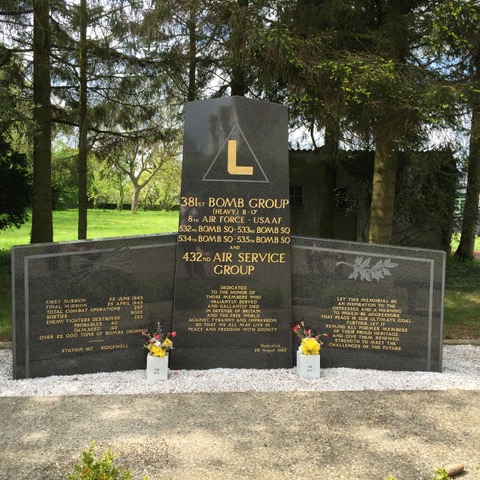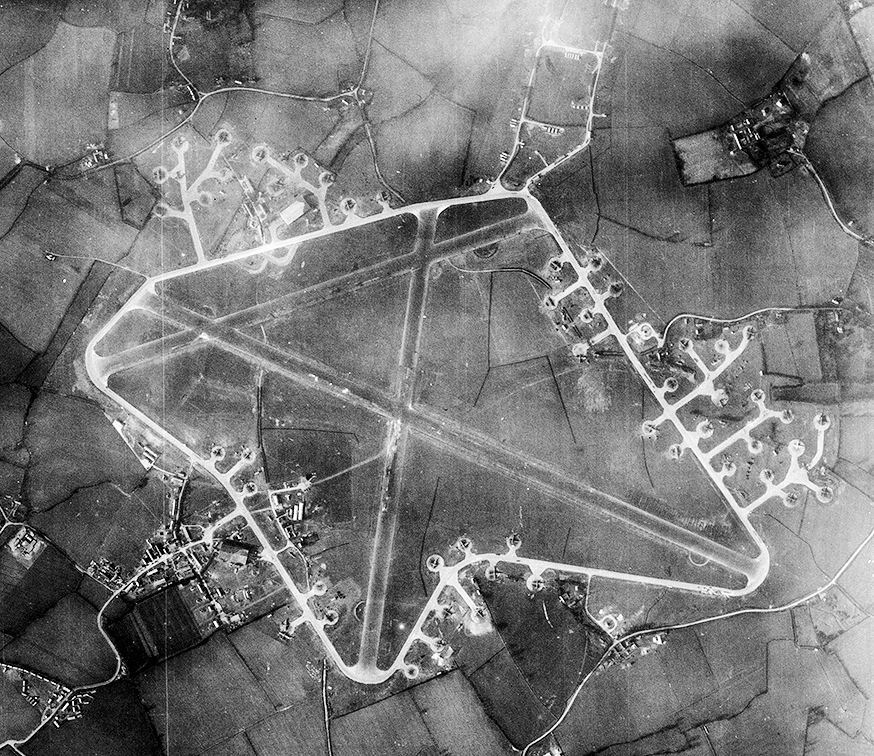381st Bomber Group (Heavy) Memorial- Ridgewell
Details:
After entering the site before the Museum on the left.
A black inscribed black marble monument consisting of three sections, about 5 feet high and 8 feet wide.
The monument remembers the 381st Bomber Group (Heavy) that was stationed at the Ridgewell Airfield, Station 167.
From the 381st Association Website:
Activated as of Jan. 1,1943, with Lt. Col. Joseph J Nazzaro, former West Point football star, designated as commanding officer, the 381st Bombardment Group began its training at Pyote, Tx., immediately after the New Year. Although the Group, as an entity, has never been there, Boise, Idaho, was named as its permanent base.
The nucleus for the new organization was virtually hand-picked by Col. Joe from the 39th and 302nd Bombardment Groups. Cadres making up the four squadrons arrived in Pyote early in January and phase training began under the direction of Col. Joe, Major Leland G. Fiegel, Air Executive; and Major Conway S. Hall, Operations Officer. The station had only been in existence about four months, and living conditions were somewhat primitive. Training aids and air supplies were practically nonexistent.
The first mission was flown June 22, with Col. Joe in the lead ship. Our target was an airfield at Antwerp, Belgium, and the contingent was composed of 21 aircraft. There was fighter and flak opposition, with two Fortresses lost and two others returned severely damaged with casualties aboard. The first air hero was developed on the mission, T/Sgt. John D. Sinclair, radio operator, who was subsequently awarded the Silver Star for his heroism that day.
While the airplanes were being loaded for the next day's mission, there was an accident on the line. A bomb went off and 23 of the ground crew, together with a civilian, lost their lives in the explosions. They flew, nevertheless and continued to fly, participating in most of the Eighth Air Force operations from then on.
Rarely was a mission flown in those early days without running into German fighters, as well as German flak, and it was seldom the formation returned without losses, or without casualties. They struck steadily deeper and deeper into enemy territory, varying the blows occasionally, with a punch at installations protecting the area in which the Allies were destined to begin the eventual invasion of the continent. The station officially became American August 2, when Col. Joe received it, with appropriate ceremonies, from the RAF. With the Eighth Air Force, the 381st came of age August 17 when they participated in the great air attack on the vital ball bearing factories at Schweinfurt. Col Hall was in the lead ship.
They fought our way to the target through swarming enemy fighters and thick flak to hit the objective, and then fought their way out again. Of the contingent of 22 aircraft , there were eleven airplanes and ten crews lost, one of the crews returning safely to base after a successful ditching in the Channel. The 381st accounted for 22 of the German fighters shot down that day. They went back to Schweinfurt Oct. 14. This time, although Eighth Air Force losses were at least as large as they were on August 17, the 381st lost only one Fortress.
The contingents grew increasingly larger in succeeding missions as the size and tempo of Eighth Air Force operations increased. Long range fighter escort enabled the 8th to penetrate deeper and deeper into Germany, striking blow after blow at the vital centers of enemy production. Lt. Col. Harry P. Leber, Jr., was transferred into the Group in December, as Air Executive, and he took over command in January, when Col. Joe moved upstairs to USSTAF headquarters. Col. Hall became Air Executive.
January 11, the 381st participated in the attack on Oschersleben, ploughing through flak and determined enemy fighter opposition to help smash the target. With the First Bombardment Division, of which the 381st was part of, they earned, that day, the Presidential Citation for battle honors, an award which entitles all members of the organization to wear the Blue ribbon on the right breast. They were given official credit for the destruction of 28 German fighters that day.
During 1944 the Group reached a peak of effectiveness and maintained it. For several months, the 381st was in the top rank in the entire Eighth Air Force for bombing results. They flew 32 consecutive combat missions without an "abortive," a tribute to work of the engineering sections, under Major Edgar C. Kurner, and the Sub-Depot, under Lt. Col. Raymond D. Jolicoeur. At last, on March 6, the 381st began to attack the heart of Nazidom, Berlin. And on April 27 they flew their hundredth mission, an attack on the airdrome at La Glacerie, one of the series of blows which paved the way for the invasion. The 381st participated in the D-Day missions of June 6, flying two operations that day, and in the period surrounding D-Day flew nine missions in seven consecutive days.
Two men participated in all nine missions. They flew their 200th mission October 9. It is symbolic that the target that day was Schweinfurt, and it is indicative of the trend of the air war that they suffered no losses. Col. Leber completed his duties in January, 1945 and in February, Col. Hall took over command of the Group. Under his guidance they carried on the performances and traditions which made the group famous.
The final mission took place April 21, 1945, and the objective was Munich. With it, they completed 297 combat operations, in the course of which they had hit just about every important target in German hands. Berlin and its vicinity felt the weight of their bombs 20 times. The 381st was officially credited with the destruction of 223 enemy aircraft and they "probably destroyed" and"damaged" many more. The 381st dropped more than 22 thousand tons of bombs.
Bombardment Squadrons of the 381st BG:
532nd - Heavy
533rd - Heavy
534th - Heavy
535th - Heavy
Combat Aircraft:
B-17F
B-17G
Stations
Ridgewell, England: 31 June 1943 to 24 June 1945
Group COs
Col. Joseph J. Nazzaro, 5 Jan 1943 to 9 Jan 1944
Col. Harry P. Leber Jr., 9 Jan 1944 to 6 Feb 1945
Lt. Col. Conway S. Hall, 6 Feb 1945 to June 1945
Missions
First Mission: 22 June 1943
Last Mission: 25 Apr 1945
Missions: 296
Total Sorties: 9,035
Total Bomb Tonnage: 22,160 Tons
Aircraft MIA: 131
Major Awards:
Distinguished Unit Citations:
8 October 1943: Bremen
11 Jan 1943 to all 1 BD groups
Claims to Fame
Highest losses of all groups on first Schweinfurt mission on 17 August 1943
Monument Text:
The text on the monument is written in English and is inscribed in three sections:
Center Section:
(Symbol of the Large “L” in a triangle which was on the tail of each aircraft)
381st BOMB GROUP
(HEAVY) B-17
8TH US AIR FORCE – USAAF
532ND BOMB SQ 533RD BOMB SQ
534 BOMB SQ 535 BOMB SQ
432ND AIR SERVICE
GROUP
DEDICATED
TO THE HONOR OF
THOSE MEMBERS WHO
VALIANTLY SERVED
AND GALLANTLY DIED
IN THE DEFENSE OF BRITAIN
AND THE FREE WORLD
AGAINST TYRANNY AND OPPRESSION
SO THAT ALL MAY LIVE IN
PEACE AND FREEDOM WITH DIGNITY
Right section:
LET THIS MEMORIAL BE
AN INSPIRATION TO THE
OPPRESSED AND A WARNING
TO WOULD BE AGGRESSORS
THAT PEACE IS OUR ULTIMATE GOAL
FURTHER, LET IT
REMIND ALL FORMER MEMBERS
OF THEIR PROUD HERITAGE
AND GIVE THEM RENEWED
STRENGTH TO MEET THE
CHALLENGES OF THE FUTURE
LEFT SECTION:
FIRST MISSION 22 JUNE 1943
FINAL MISSION 25 APRIL 1945
TOTAL COMBAT OPERATIONS 297
SORTIES 9035
ENEMY FIGHTER DESTROYED 223
PROBABLES 40
DAMAGED 162
OVER 22,000 TONS OF BOMBS DROPPED
STATION 167 RIDGEWELL
Dedicated
28 August 1982
Commemorates:
People:
Units:
381st Bomber Group (Heavy)
432nd Air Service Group
532nd Bomber Squadron, 381st Bomb Group
533rd Bomber Squadron, 381st Bomb Group
534th Bomber Squadron, 381st Bomb Group
535th Bomber Squadron, 381st Bomber Group, Heavy
8th Air Force
United States Air Force
US Army Air Corps
Wars:
WWII
Other images :





